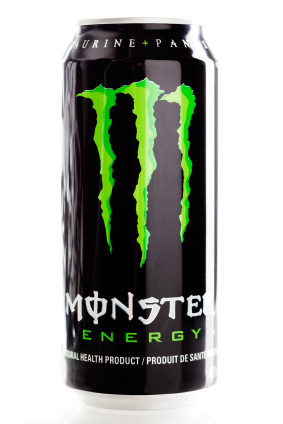 Many people routinely use caffeine to boost their energy levels, whether it is a cup of coffee to help them perk up in the morning or a Coke to help them get through that post-lunchtime energy crash without a nap. Most of the time, no ill effects ensue. In fact, caffeinated products are so ubiquitous in our society that it’s easy to forget that caffeine overdoses can be deadly.
Many people routinely use caffeine to boost their energy levels, whether it is a cup of coffee to help them perk up in the morning or a Coke to help them get through that post-lunchtime energy crash without a nap. Most of the time, no ill effects ensue. In fact, caffeinated products are so ubiquitous in our society that it’s easy to forget that caffeine overdoses can be deadly.
But there are some people who will never forget: the families of teens and young adults who have died or suffered devastating brain injuries after drinking caffeine-packed Monster energy drinks.
Monster Beverage is currently the target of a growing body of lawsuits based on these injuries and deaths. The lawsuits allege that Monster marketed their highly caffeinated energy drinks to kids, teens, and young adults without proper warnings of the risks inherent in consuming the beverages, and should be liable for the damages this caused.
High-Profile Monster Energy Lawsuit Still Ongoing
The most well-known lawsuit related to Monster energy drinks is a wrongful death case brought by the family of Anais Fournier.
Anais Fournier was a normal, happy 14-year-old, who enjoyed the typical teen pastime of hanging out at the mall. Apparently it was her habit to purchase and drink a 24-ounce can of Monster energy drink as part of her mall-hanging ritual. On the night of December 16, 2011, Anais visited the Valley Mall in her hometown of Hagerstown Maryland, where she purchased and drank a 24-ounce can of Monster. The next day, she again purchased and drank another Monster. Later that night, while watching a movie with her boyfriend in her home, she went into sudden cardiac arrest.
After being taken first to a local hospital and then air-lifted to Johns Hopkins in Baltimore, Anais was placed in a medically induced coma in an effort to control swelling in her brain. She never woke up. Instead, she was declared brain dead on December 23, 2011, forcing her family to make the incredibly difficult decision to take her off life support. Her official cause of death was listed as “cardiac arrhythmia due to caffeine toxicity.”
In the 48 hours before she went into cardiac arrests, Anais Fournier had consumed 480 milligrams of caffeine from Monster drinks. She had also consumed an unknown amount of “masked” caffeine, aka ingredients that either contain caffeine or mimic the effects of caffeine on cardiac muscles. Monster drinks have two such sources of masked caffeine: guarana extract and taurine.
Considering that experts say that a dose of anywhere from 200 to 400 milligrams of caffeine can be deadly for a child or young adult, it seems entirely reasonable to conclude that Fournier’s death was caused by a caffeine overdose.
Anais Fournier’s mother said that the family’s decision to bring a wrongful death case against Monster was not motivated by money. After all, no amount of money can bring back a lost child. However, filing a lawsuit did accomplish another goal for the grieving family: alerting a national audience to the dangers associated with energy drinks, in the hopes that no other families would suffer a similar loss of a child.
Why Are Monster Energy Drinks Still on the Market?
Anais Fournier’s mother said she was “shocked” to learn that the FDA does not regulate energy drinks, and that Monster drinks were still on the shelves in 2011 despite a history of energy-drink-related deaths and hospitalizations dating back to 2004. And of course Monster drinks are still being sold today, despite all the publicity Fournier’s mother has drawn to the issue.
Why is this?
Because while energy drinks may be packaged like a soda, they are not regulated like a soda. Instead, they are considered a supplement. This means the FDA does not hold them to the same food safety standards as a soda. While a caffeinated soda is limited to 71 mg of caffeine per 12 ounce serving, there is no limit for an energy drink sold as a supplement.
Worse still, as a supplement an energy drink is not required to carry a detailed label describing its ingredients. When ingredient labels are present, they are often inaccurate. One investigation by Consumer Reports found that 27 of the most popular energy drinks sold in the US contained different amounts of caffeine than advertised on the label. This is extremely dangerous, because it means even in the rare cases where a young person might be savvy enough to check the label to see how much caffeine they would be imbibing per serving of energy drink, they might still end up overdosing and putting their health at risk.
While FDA Analysis Drags On, Personal Injury Attorneys Provide Help
The FDA has been studying the effects of energy drinks for years. They currently have about 300 adverse event reports to consider, including at least 34 deaths. However, despite the fact that numerous groups are now lobbying for energy drinks to at least carry a warning label—or better yet, be classified as a food product and regulated accordingly—no action from the FDA seems forthcoming. They understandably want to be very certain that the adverse health events are being caused by the energy drinks and not by any pre-existing health conditions or other complicating factors.
However, some progress is being made in the fight to secure compensation for victims of injuries and wrongful deaths related to Monster energy drinks. Two lawsuits have actually been settled out of court this year, providing much needed closure (and an undisclosed amount of compensation) to the families of two young men who suffered fatal heart problems after consuming Monster energy drinks.
In the end, it may be impossible to make the world a perfectly safe place, but fortunately we can help make it a fairer place by using the provisions of personal injury law to hold companies like Monster responsible for their actions.




